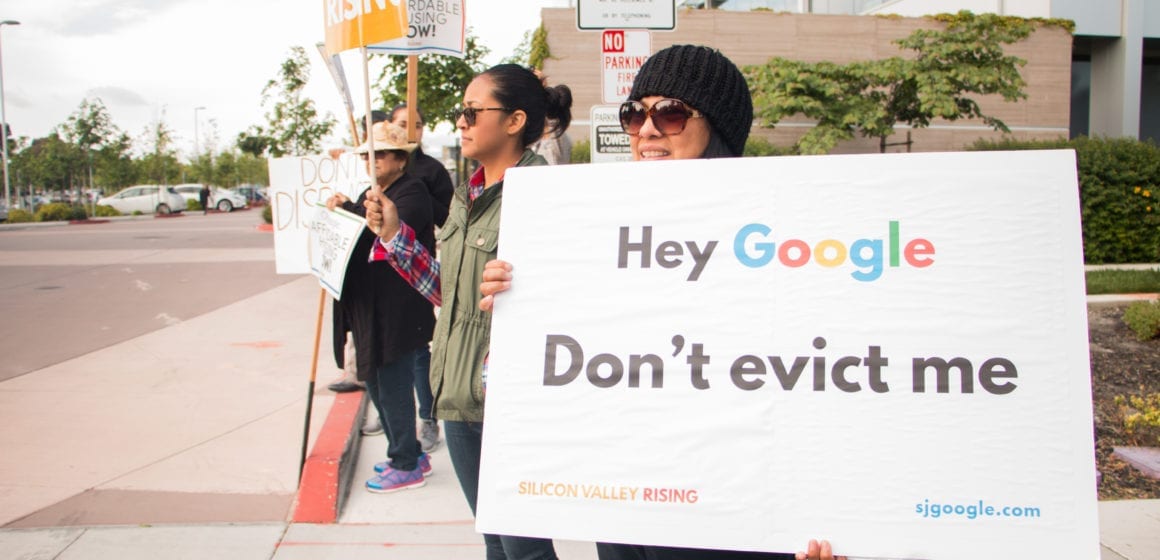Since Google first announced plans to build a new mega-campus in San Jose, the top concern raised by residents has been how the project will impact rising rents and displacement.
Over the past decade, the tech boom has brought nearly 200,000 new workers to Santa Clara County, but fewer than 50,000 new homes have been built. That’s driven rents up far faster than wages, creating a historic housing crisis.
While rents have skyrocketed, the city of San Jose has failed to meet the affordable housing goals identified by the state and Mayor Sam Liccardo. Just 8% of the needed low-income homes have been built and the city admits it’s nearly half a billion dollars short of the mayor’s goals.
With working families already stretched to the breaking point, Google’s new project is set to bring an additional 20,000 highly paid Google workers and an estimated 8,000 low-wage subcontracted service workers to San Jose, creating further demand for affordable housing.
Google says it will build housing but remains silent on details, leaving many to question whether Google’s development will lead to more displacement, and how it can be avoided.
This is why we commissioned Beacon Economics, an independent research firm with a long history of research for cities across California – as well as chambers of commerce and even the California Apartment Association – to study these questions.
The findings are sobering. Unless Google creates enough affordable homes, people who rent their homes will pay an extra $235 million every year in rent once the campus is fully operational (the study assumes Google workers will be phased in between 2024-2030). Families who rent in San Jose would be hit the hardest with an $816 Google rent hike annually.
By the time Google’s campus is built, Asian, African American and Latino families would have to spend between 38% and 53% of their income on rent on average, making it even more difficult for communities of color to remain in San Jose.
These data paint a grim picture, but rent increases are not inevitable. Beacon Economics also calculated the housing needed to meet the demand created by Google’s campus and avoid further displacement: More than 5,284 new affordable and 12,450 market-rate homes. These are on top of the targets set by the state and mayor (developed before there was a Google project for the city to consider).
But why should we expect Google to address its impacts? San Jose is selling Google valuable public lands, doubling Google’s development capacity, letting the company rewrite land use plans, and allowing it to shape $10 billion in public investment coming together at Diridon. We should expect more from Google.
The good news is with the right combination of strategies, Google and the city of San Jose can prevent more rent hikes, displacement, overcrowding and super-commutes.
The most direct way Google can act is to simply build homes. The city has set a goal that 25% of all new homes in the area would need to be affordable. If Google includes a large number of housing units in its plans and complies with that goal, it will go a long way toward building enough affordable homes in the area. In addition to its own construction, Google should advocate for the city to allow 12,450 total units overall across the 240 acres in the Diridon Station Area.
If San Jose passed a commercial linkage fee and charged fees in line with what developers like Google pay in places like Sunnyvale and Mountain View, that could subsidize 960 to 1,600 affordable homes.
When Google was developing a big expansion in Mountain View in 2015, it offered to pay more than $110 (adjusted for inflation) per square foot of development for community benefits and impact fees, including for affordable housing. If the San Jose City Council negotiated a similar deal, that would equal nearly $900 million. Focusing Google’s community benefit plan on affordable homes and legal support for tenants facing eviction will be important to achieving these goals.
If the city of San Jose negotiated these commitments from Google and dedicated a portion of construction taxes, public land sale proceeds and future district financing plans, those 5,284 affordable units are within reach.
With big developers like Jay Paul, Boston Properties and Gary Dillabough planning massive developments across San Jose, displacement will only get worse unless we create a new model, starting with Google. This project presents a chance for tech development to create opportunity rather than more displacement. It’s time to end the trail of tech-driven gentrification, evictions, and destabilizing inequality, so all San Jose families – white, black, brown, and – have the freedom to stay and thrive as Google grows.
Jeffrey Buchanan is the director of public policy at Working Partnerships USA, a labor think tank based in San Jose.



Leave a Reply
You must be logged in to post a comment.